Search for Land
By Jim Boyle
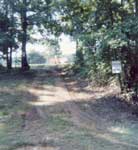 When St. Andrew Mission Parish was started, St. Michael’s Parish purchased land for the new parish. As we began formulating plans for our parish, we discovered that 97% of the St. Andrew’s parishioners lived closer to St. Michael’s Church than the new land. So we sold the land and started the search for new land.
When St. Andrew Mission Parish was started, St. Michael’s Parish purchased land for the new parish. As we began formulating plans for our parish, we discovered that 97% of the St. Andrew’s parishioners lived closer to St. Michael’s Church than the new land. So we sold the land and started the search for new land.
We found it. It was on Route 64 and perfect for our parish. The Apex sewer system was miles away; which meant a septic system was necessary. Because the church building was to be designed for at least 750 people, we’d need a septic system to support 750 people. With Lake Pine nearby, that was impossible. So we restarted the search for land.
We found it. The land was 60 acres on Old Raleigh Road and was owned by three family members. Initially they did not want to sell the land. After much discussion they agreed to sell but only with a land swap. We would be required to buy three pieces of land: one in North Carolina, one in Tennessee, and one in Texas. After more discussion, they finally agreed to accept money.
The parish needed 12 acres for the church, offices, and classrooms. The diocese would only buy 12 acres. The sellers would only agree to sell all 60 acres. At $12,000 per acre we had a $576,000 problem.
Four wonderful parishioners came forward and said they would buy the 60 acres and sell 12 acres to the diocese for St. Andrew’s buildings. These four men pledged to donate all profits made on the sale of the remaining 48 acres to St. Andrew’s parish or the diocese. St. Andrew’s buildings were started and in a few years the parish was further blessed by receiving the profits from the sale of the 48 acres.
Four dedicated and generous parishioners made a big difference. St. Andrew Parish is about people making a difference.
Building Our Church
 St. Andrew’s church in a literal sense finds its foundation in the cross. In 1986 during the initial building phase for the church, a liturgical consultant was brought in to help planners reflect not just on creating a structure, but rather what the church should mean. Our church was therefore planned in the round, which was a new idea in the area at the time, in order to be inclusive. The cross, an important symbol of the Friars of the Atonement, would be the foundation both literally and figuratively.
St. Andrew’s church in a literal sense finds its foundation in the cross. In 1986 during the initial building phase for the church, a liturgical consultant was brought in to help planners reflect not just on creating a structure, but rather what the church should mean. Our church was therefore planned in the round, which was a new idea in the area at the time, in order to be inclusive. The cross, an important symbol of the Friars of the Atonement, would be the foundation both literally and figuratively.
Reflecting the Franciscan order’s simplicity, the cross originally was plain with no corpus. Beams in the ceiling were to give the illusion of emanating from the cross.
The cross itself is very functional. It supports all the beams, and is the main support of the roof. Concrete support beams are under the wooden facade around the cross and beams.
Fr. Bill Schmidt explained the thinking behind using the cross as the foundation. “It was an important part of who we were, and tied in with the whole sense of St. Andrew, the first called, and his cross.”
The corpus was later added to the cross in 1996.
Faith Development
By Sister Anne Heath
 St. Andrew the Apostle was a thriving, vibrant parish community that attracted me because of the hospitality and warmth that was felt at each liturgy. The charisma of the Friars of the Atonement and the Sisters of Mercy was felt at each assembly.
St. Andrew the Apostle was a thriving, vibrant parish community that attracted me because of the hospitality and warmth that was felt at each liturgy. The charisma of the Friars of the Atonement and the Sisters of Mercy was felt at each assembly.
Faith Development’s goal was defined as “womb to tomb,” meaning to include all ages from baptism through death. I was privileged to participate in every aspect of that. We tailored every ministry to the need of the time. For example, with so few babies at the time, we had a team that would visit each family in the home first, hold instructional sessions, and follow up sessions prior to baptism.
Our youth program was strong because we had many committed couples who would take the time to engage the teens. We won Youth Group of the Year our first year at Convention! From then on, St. Andrew’s Youth (TYM) was recognized throughout the diocese for their service to the community and spirit.
Vacation Bible School began in the Methodist Church in 1987 with approximately 12 kids. As time went on it grew and grew and became “the event of the summer.” Many college age kids today still talk about the experience.
Over time, changes have occurred due to the parish’s size and personnel changes. But the underlying spirit and effort behind Faith Development remains: to impart knowledge of the faith AND to love and serve the Lord and one another. In other words, live the saying “That All May Be One” in love and charity.
First Mass & Baptism
By John Calcagni
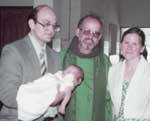 It was early August in 1983 and a ripple of excitement went through the “St. Apex” community. We had just learned that Bishop Gossman announced our mission church that met at Apex High School was to become St. Andrew the Apostle Parish. More importantly, he had found priests for us.
It was early August in 1983 and a ripple of excitement went through the “St. Apex” community. We had just learned that Bishop Gossman announced our mission church that met at Apex High School was to become St. Andrew the Apostle Parish. More importantly, he had found priests for us.
The Franciscan Friars of the Atonement had agreed to staff and manage the new parish. They would be sending two priests, Father Bill Schmidt as Pastor and Father Joseph Cavoto on the first of September. Our first mass as St. Andrew the Apostle Church would be said at Apex High School on Sunday, Sept. 4, 1983. For months we had been concerned that Bishop Gossman might not be able to find us a priest and now we had two!
On Aug. 14, 1983, our son, John Edgar Calcagni, was born. As early, active members of the parish we were part of the welcoming committee to help our new priests “settle in” when they arrived. When the opportunity arose, I explained to Father Bill that we had a newborn child we’d like to baptize in the near future. He suggested we do it at the first mass. Hence Sept. 4, 1983, was the beginning of both our son’s Christian life and of the parish of St. Andrew the Apostle Church.
Community Outreach
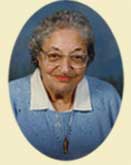 Outreach to the needy has been a trademark of St. Andrew’s parish since its inception. While many parishioners have given countless hours and donations over the past 25 years, Antoinette Clark still shines as an archetype of our parish’s ministry to the poor.
Outreach to the needy has been a trademark of St. Andrew’s parish since its inception. While many parishioners have given countless hours and donations over the past 25 years, Antoinette Clark still shines as an archetype of our parish’s ministry to the poor.
Antoinette was a founding member of the parish, and along with Fr. Joe Cavoto, began the Western Wake Crisis Ministry (WWCM) in the mid 1980s. She wouldn’t let anything deter her quest to support those struggling financially, even lobbying public officials and utility departments to adopt changes that benefited indigent clients.
When it was time to collect bags of food at holidays, Fr. Joe would introduce her as “our bag lady” to speak at church. Not quite 4 feet 11 inches tall, she barely could be seen over the podium. What she might have lacked in height, she more than made up for in conviction and personality.
She had a reputation for telling it like it was, and people respected her for it. One story recalls how she and her sister always played bingo once a week. Once at the Crisis Center a gentleman came in to get his groceries for the month. She looked at him, told him he couldn’t get any, and said, ‘You can take that $200 you won at bingo last week and buy groceries.’
Antoinette also went to speak at other local churches seeking their support, and thus created the WWCM as an ecumenical community effort. She died in August 2001, but her impact is still felt strongly in our parish and community. In addition to the continuing support of WWCM, our parish reaches out to those less fortunate by collecting food, sheltering the homeless, building homes, and above all, offering hope.
Father Bill’s Garden
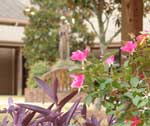 Father Bill was a very enthusiastic gardener- his free time while serving the St. Andrew community was spent reading plant catalogs and visiting nurseries. On his return he would call Kathleen Thompson, Sally Halliday, or Rosanna Adams and ask them to find a spot on the grounds for a few plants – including hundreds of bulbs.
Father Bill was a very enthusiastic gardener- his free time while serving the St. Andrew community was spent reading plant catalogs and visiting nurseries. On his return he would call Kathleen Thompson, Sally Halliday, or Rosanna Adams and ask them to find a spot on the grounds for a few plants – including hundreds of bulbs.
After a while they decided to get help by forming a garden committee. One of the group’s tasks was replacing flowering trees in the courtyard which had been vandalized with the present magnolias. The garden committee, like gardeners everywhere, didn’t like to see good plants go to waste so they found places to plant the azaleas and lilies that had been Altar Easter decorations as well as the evergreens at Christmas.
On the hill where the columbarium is located now, was Father Bill’s rock garden. The other part was ivy. Speaking of hills, the committee decided to plant junipers on the hill near the parking lot to try to hold down the weeds and keep the soil from washing away with the rains. It seems the after-hours bikers thought this was a pretty neat obstacle challenge. In spite of being ridden over or maybe because of it, the junipers settled in, filled out, and covered the space as they were intended to do.
Rosanna Adams remembered working on the hill one day when a gentleman came by and said – “I would have taken the three Hail Mary’s!”
Music Ministry
By Lynn Brugnolotti and Cheryl Koller
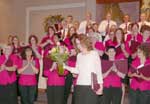 Music ministry leads our faith community in praising the Holy Trinity. Each week, the music reflects the theme presented in the Liturgy of the Word, and celebrates the joy of the Eucharist.
Music ministry leads our faith community in praising the Holy Trinity. Each week, the music reflects the theme presented in the Liturgy of the Word, and celebrates the joy of the Eucharist.
Lynn Brugnolotti, who was Director of Music Ministry for 17 years at St. Andrew, explained, “Providing the sung texts of the weekly Eucharistic celebration is both the ordinary and extraordinary thing we do that makes us different from other Christians.”
Those serving in the music ministry also share in a unique way in pivotal occasions of our faith. For Lynn, there is nothing like the joy of being with families at the grace-filled times of their lives – the weddings, the baptisms, the first communions, the confirmations, the funerals – all the times that make us who we are.
She also recalled one of her most moving moments: “One of my favorite memories from St. Andrew’s is of the dedication Mass. The dedication of a church is a huge event – a liturgical tour-de-force! And it was very early in my career as a music minister. Sister Anne Heath, RSM, and I were working around the clock (along with the rest of the staff) to make sure that everything happened just right. At the very end of the Mass, as the last notes of the closing song sounded, she literally RAN across the front of the sanctuary and leapt into my arms! We were so overcome with joy and relief – I don’t know which emotion was more pronounced!”
Early Childhood Center
By Eileen Vaughan
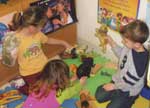 The Early Childhood Center (ECC) began as an answer to a prayer. I had been asking God to let me know what He wanted me to do now that both my children were in school. One day Sister Anne called and asked if I would help start a preschool at St. Andrew.
The Early Childhood Center (ECC) began as an answer to a prayer. I had been asking God to let me know what He wanted me to do now that both my children were in school. One day Sister Anne called and asked if I would help start a preschool at St. Andrew.
A committee began meeting in February 1989, and the first classes started in September 1990. All along the way, God made His presence known in very real ways. When I was despairing because we needed to find teachers to open the school, a flood of resumes came in. When our finances were tight, someone made an unexpected donation. When we needed more drawing paper, someone walked into the office with a couple boxes of paper to donate. The stories are nothing short of miraculous!
Of course, there were challenges along the way, but always, God was with us.
What are the best things about the ECC? Of course, that would be the children who have passed through our doors—the first classes are now in college! I smile when I hear reports of how many ECC parents are running into each other at Cardinal Gibbons, or parents who tell me how pleased they have been to be with other former ECC families as they prepare for First Communion and Reconciliation.
The ECC helped people meet each other and become part of the larger parish community of St. Andrew. It has been a blessing to children, parents, and teachers alike. Thank You, God, for giving us the ECC!
Stations of the Cross
By Fr. Joe Cavoto
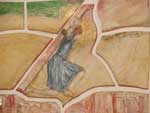 From the earliest days when Saint Andrew was without land on which to build, I knew one day the worship space would need Stations of the Cross. The Stations were conceived by Saint Francis as a way for Christians in places of the world to walk the way of the cross.
From the earliest days when Saint Andrew was without land on which to build, I knew one day the worship space would need Stations of the Cross. The Stations were conceived by Saint Francis as a way for Christians in places of the world to walk the way of the cross.
Considering that Saint Andrew was a new parish in 1983 and Catholics were becoming a more visible presence in North Carolina, the conversations with artists and crafts people were to say the very least, interesting. A few artists sent me sketches and soon the list narrowed. Each artist had an interesting story to match their rendering of what it meant to them to walk Jesus’ way to the cross.
The Stations of the Cross were crafted by Catherine Pasco, an artist from Durham. Catherine Pasco grew up a Roman Catholic near Richmond, Virginia. She “understood” the Cross and the way to it and beyond. Her inspiration for the Stations came almost as a revelation. Catherine told me she went through many sketches, and one day she found herself in a grocery store and looked up behind the counter and there it was, a colorful poster. On closer look at the poster she realized it was a calendar, the words were in Spanish, the images were the Stations of the Cross.
Catherine took the vibrant colors and “muted them” once she visited Saint Andrew’s church. She soon began to produce prototypes for the committee to comment upon and choose. What emerged were segments of a whole image. Catherine explained, “life is like that, we are putting life together each day. Some days life feels whole and on other days pulled apart by sadness or struggle. Christ pulls all things together as we walk with Him.”
St. Andrew Statue
By David Legarth
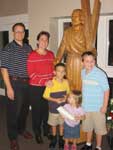 Several years ago, I looked through photos of myself growing up in Cleveland, Ohio, and noticed a comforting pattern. Every Sacrament and special occasion my family celebrated always included a picture of us standing in front of a statue of Saint Patrick. This particular statue of our parish’s patron was dedicated on Christmas Eve, 1973, as a part of our parish’s 125th anniversary.
Several years ago, I looked through photos of myself growing up in Cleveland, Ohio, and noticed a comforting pattern. Every Sacrament and special occasion my family celebrated always included a picture of us standing in front of a statue of Saint Patrick. This particular statue of our parish’s patron was dedicated on Christmas Eve, 1973, as a part of our parish’s 125th anniversary.
With each photo I could see how my family changed over the years; my family grew in number, we got older and taller, and thankfully our hairstyle and clothes fashion changed, but even after 34 years the white alabaster Saint Patrick statue has remained unchanged.
In 2005, when I approached Fr. David about having the Saint Andrew statue sculpted, I just wanted our parish family to also have that unchanging link to the parish and the past. My hope was to see families taking pictures next to the Saint Andrew statue after each Sacrament and special occasion that they celebrate, so that they too in the future, where ever they are, can look back and watch their family change and have fond memories of Saint Andrew the Apostle Roman Catholic Church.
St. Andrew Columbarium
By Pete Burke
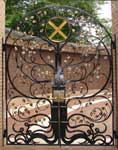 When St. Andrew the Apostle Parish began in 1983, the practice of cremation, though permissible by Canon law, was rarely considered a viable means for the disposition of the dead; indeed most Catholics were unaware that it was allowed. As time passed and cremation in America became more widely practiced, the shroud was lifted so to speak and Catholics began to utilize cremation more.
When St. Andrew the Apostle Parish began in 1983, the practice of cremation, though permissible by Canon law, was rarely considered a viable means for the disposition of the dead; indeed most Catholics were unaware that it was allowed. As time passed and cremation in America became more widely practiced, the shroud was lifted so to speak and Catholics began to utilize cremation more.
The Church is central in our lives. We attend Mass weekly or daily sure, but there is so much more we do. Weddings, baptisms, other sacraments, religious education for children and adults, social gatherings – the list goes on. But something was missing …
Many of the older churches in our area, indeed throughout the western world, have set aside space for the burial of the dead on church grounds. What perfect sense this makes! We worship God and obey His laws in the sure and certain hope that doing so leads us to eternal life with Him. We pray for ourselves and for our dead who have gone before us – as individuals, as families, and as a parish family. Our ultimate goal is to be as close to God as we can be. So, providing a sacred place for our earthly remains on the grounds where we worship is ideal.
Our Columbarium is placed between the Church and the Chapel to surround it with prayer. The unique curvature of the structure upon itself symbolizes the Hands of God, cradling those who rest within. There are memorial plaques to honor and remember those family members whose remains rest elsewhere. From a practical perspective, it provides the convenience of making a visit without having to make a special trip to an out-of-town cemetery.
After several years of planning, the Columbarium was dedicated on All Souls Day 2006 to the glory of God and in loving memory of those who rest there and await Jesus’ return in glory.
Franciscan Friars of the Atonement
 In 1898, Fr. Paul Watson established the Franciscan Friars of the Atonement religious community with a mission of reconciliation and healing through atonement — the unity of men and women with God and one another. The Friars of the Atonement first came to North Carolina in 1941 under Bishop Eugene McGuinness to lead three small parishes in Lumberton, Kinston and High Point. At that time, the entire state was the Diocese of Raleigh.
In 1898, Fr. Paul Watson established the Franciscan Friars of the Atonement religious community with a mission of reconciliation and healing through atonement — the unity of men and women with God and one another. The Friars of the Atonement first came to North Carolina in 1941 under Bishop Eugene McGuinness to lead three small parishes in Lumberton, Kinston and High Point. At that time, the entire state was the Diocese of Raleigh.
Under the request of Bishop Joseph Gossman in 1983, two Friars of the Atonement, Fr. Bill Schmidt and Fr. Joe Cavoto, came to Apex to begin St. Andrew the Apostle parish. Our parish is the only parish in the Diocese of Raleigh still staffed by Friars of the Atonement.
As Franciscans, a ‘charism’ or feature of the Friars has always been outreach to the poor. The founder of the Friars of the Atonement began St. Christopher’s Inn for homeless men in Graymoor, NY that still operates today. In that same spirit, our parish serves the homeless and needy by offering shelter, food and financial support.
Another charism of the Friars is hospitality. From the earliest days of our parish working in an ecumenical spirit with neighboring churches, to the continuing work in our community, St. Andrew’s parishioners have embraced this hallmark of the Friars. Their philosophy is reflected in our church mission statement.
Our parish is indebted to all the Friars who have served St. Andrew the Apostle Catholic Church during its first 25 years: Fr. Bill Schmidt (pastor), Fr. Joe Cavoto, Fr. Bob Langone, Fr. Ed Gallagher, Fr. Ken Cienik, Fr. Mark Traenkle, Fr. Alban Carroll , Fr. David Fitzgerald (pastor), , Fr. Frank Eldridge, Fr. George Ribeiro, and Fr. Tom Gumprecht.

